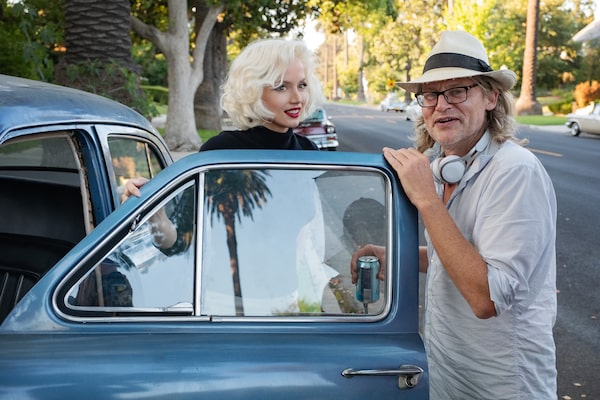
Ana de Armas and Director Andrew Dominik.Matt Kennedy/Netflix
It remains unclear just what Netflix was expecting. After hiring the New Zealand-born, Australian-raised filmmaker Andrew Dominik to adapt Joyce Carol Oates’s Marilyn Monroe novel Blonde, the streaming giant could not have possibly anticipated a traditional biopic. Not only because Oates’s acclaimed novel is a sprawling work that never pretends to stick to known history, but also because Dominik has built a career on subversion.
His 2012 film Killing Them Softly is a crime thriller that is more philosophical than violent (though when the violence arrives, it is supremely uncomfortable). His 2007 masterpiece, the beautiful and meditative The Assassination of Jesse James By the Coward Robert Ford, is a western in name only. So when Blonde arrived to Netflix – complete with a meta-contextual bent, copious nudity that is anything but titillating, and a handful of shots that would earn the infamous NC-17 rating from the Motion Picture Association of America – a conundrum presented itself for the streamer. And not a little bit of media drama.
Now, three years after production commenced, Dominik’s film is finally being released into the world – and the director again finds himself defending himself against those who were expecting something different, more palatable, safer.
A week before Blonde begins its long-delayed streaming debut on Netflix, Dominik spoke with The Globe and Mail about making a proudly ugly film about America’s favourite sex symbol.
This film plays like a waking nightmare.
Yeah, it’s a dream film.
You’re mixing different cinematic elements every few seconds: different aspect ratios, different film stock, different colour schemes. How much of the film was found in the editing room, versus on the page of your script?
It was all on the page, it was all designed. The big idea was to traffic in images that were familiar. Marilyn is so photographed that you know the imagery of her life, whether you actually know it or not. We’re reseeing that cultural memory of ours through the lens of her own fears and desires. So some images are in a square aspect ratio because they’re based on an original square image. Some are in black and white because they’re based on black-and-white images. It’s a little risky to make a film so inconsistent, but the end result doesn’t bother me at all.
What was your first cultural memory of Marilyn Monroe, when you were growing up?
I wasn’t that interested in her, actually. Obviously I knew the imagery of this goddess, but it wasn’t something that sunk in. But when I read Joyce’s book, I became fascinated. Now, I’m completely obsessed.
Joyce Carol Oates has said that she compares the Marilyn in her book to Moby Dick: this oversized symbol to represent everything in the culture. But your film feels more like a singular portrait of a woman destroyed, and less a heavyweight metaphor.
I understand what Joyce is saying, because her novel is experimental in the way that Moby Dick is. But I think that Marilyn represents this kind of rescue fantasy. Everyone who writes about her, whether it’s Joyce or Gloria Steinem or Norman Mailer, their takes on her might be different but the impulse is the same: having this special understanding of her and this sense to kind of see her, what she was going through. I don’t think Blonde the film is different from that. That’s the enduring appeal of Marilyn as a figure, this protectiveness that we feel toward her. And that she probably needs protection from us. When you want to rescue somebody, the person they most need rescuing from is probably you.
de Armas works with Dominik during a scene.Matt Kennedy/Netflix
The film has garnered a fair amount of drama thanks to its NC-17 rating …
I think the drama is good! It’s replaced marketing in a way. That’s the best thing that you can hope for in a way. It can of course turn around and backfire, but Blonde the film is swimming in waters right now where nobody is sure where the boundaries are. People can decide it’s politically incorrect. I have no control over that stuff. But the film is very sincere. The noise surrounding it? Well, the film was made with love and is incredibly heartfelt from my point of view. I’m not trying to be provocative.
As you were watching the news cycle play out, though, was there any point where you were genuinely concerned that the movie might never be released?
No, no, no. It seems with most of my films that there’s a kind of delay as people react to it and try to think about where it fits. I’m used to that. It’s nice that people cared about this one, that they were actually interested in it! But that’s the way things are right now. If we can make drama out of something, let’s do it. But it works in favour of the film. It could flip the other way, but as of right now, it’s okay.
Blonde is now playing in select theatres; it will be available to stream on Netflix starting Sept. 30
This interview has been condensed and edited
 Barry Hertz
Barry Hertz